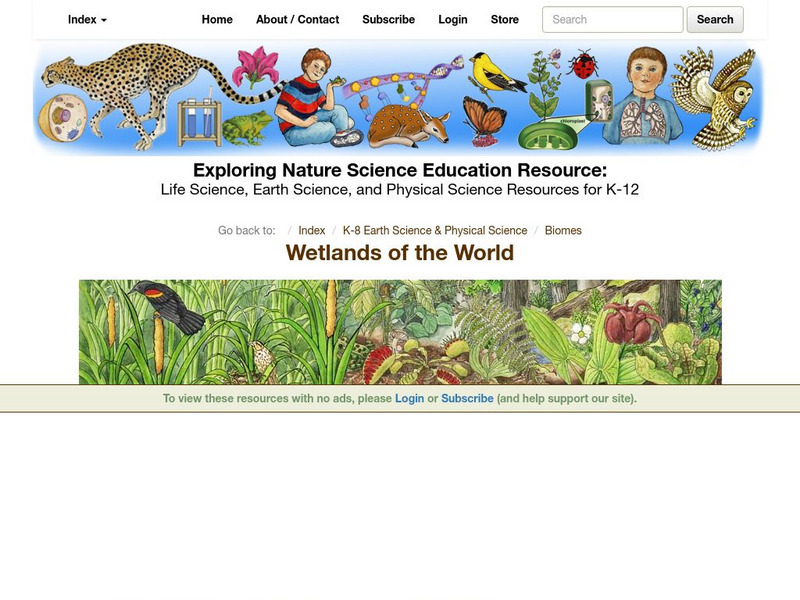Hi, what do you want to do?
Curated OER
A Model of Morphogenesis in Drosophila Melanogaster
Students investigate the following scientific terms and ideas: rates of diffusion, the role of morphogens in the development of larva, the chemical dynamics of a cell, and the significance of embryo polarity during development.
Curated OER
Project Wetlands
Students develop a joint undertaking designed to solve an environmental problem in their local community. They tackle the problem of erosion of banks and chemical run-off into a nearby lake, which is within walking distance of school.
Curated OER
Brain POP - Volcano
In this volcano worksheet, middle schoolers complete 15 fill in the blank questions on the basics of volcano structure and volcano trivia.
Curated OER
Magazine Madness
Students look at pictures cut out of magazines to determine what is happening in the picture and predict what will happen next.
Curated OER
What Is A Dinosaur?
Students use the question of "What is a dinosaur?" in order to establish the context for a class investigation. They use a variety of resources in order to gather information. Students compare and contrast the similarities or differences...
Curated OER
Observing Capitalization Rules
In this capitalization activity, students complete three activities that help them follow the rules for capitalization in their writing.
Curated OER
Fascinating Geography Facts
In this geography worksheet, students will read 4 interesting United States geography facts and 19 fascinating world geography facts.
Curated OER
What Do Maps Show?
This teaching packet is for grades five through eight, and it is organized around geographic themes: location, place, relationships, movement, and regions. There are four full lessons that are complete with posters, weblinks, and...
Curated OER
Crossword
In this crossword worksheet, students, after studying about bugs, birds and ducks, complete a crossword puzzle involving twelve key clues.
Curated OER
Teeshirt Printing
Young scholars become responsible and involved citizens. For this t-shirt printing lesson students design and create a teeshirt with a message about citizenship and responsibility. Natural objects are used as stamps.
Curated OER
Past Tense Questions “Did”
In this past tense questions activity, students read groups of sentences starting with did and ending with regular and irregular endings. Students read 2 groups of sentences.
Curated OER
Sandpaper Drawings
Students examine images of sand art from different cultures. They create their own version of a sand art picture.
Curated OER
Water Density Boundaries
Learners create observable layers in water that represent a separation based upon density differences. They model density boundaries using differences in temperature and salinity. They, in groups, perform a meaningful experiment...
Science Education Resource Center at Carleton College
Serc: How Does the Temperature of the Great Lakes Change Over Time?
This activity allows students to use water surface temperature, bathymetric data, and weather data to look at trends in the water temperature of the Great Lakes.
University of Wisconsin
University of Wisconsin: Paradise Lost?: Teaching Climate Change in the Great Lakes Region
This website is designed as a resource for high school and middle school teachers on the topic of climate change. The emphasis of this site is on providing hands-on activities. Includes activities that involve language arts, social...
Environmental Education for Kids
Eek!: Lake Superior
This site provides facts, illustrations, and more about the largest Great Lake. Includes descriptions of wildlife and industry. For grades 4-8.
Utah STEM Foundation
Utah Stem Action Center: Great Salt Lake Ecosystem
This lesson plan provides an eight-day flow of educational activities in which students use the Great Salt Lake ecosystem to explore food webs and how changes in living and nonliving factors affect different populations.
Exploring Nature
Exploring Nature Educational Resource: Wetlands of the World
A set of illustrated fact pages and activity sheets on different wetlands ecosystems, e.g. the Florida Everglades and Chesapeake Bay.
Annenberg Foundation
Annenberg Learner: American Passages: Native Voices, Chippewa Songs
Study the great oral tradition of the Chippewa Tribe in the Great Lakes regions through their music collected by Frances Densmore. For classroom activities and lesson enhancements click on the link, "Chippewa Songs Activities."
Annenberg Foundation
Annenberg Learner: American Passages: Spirit of Nationalism: Margaret Fuller
Margaret Fuller is featured for her writings during the transcendentalist movement of the nineteenth century, considered progressive for her times as women of the era were not taught to think. Click "Margaret Fuller Activities" for...
Curated OER
Etc: Maps Etc: Physical Map of South America, 1898
A map from 1898 of South America showing the general physical features including mountain systems, prominent peaks and volcanoes, river and lake systems, plateaus, and coastal features. The map includes an insert of the Isthmus of...
























